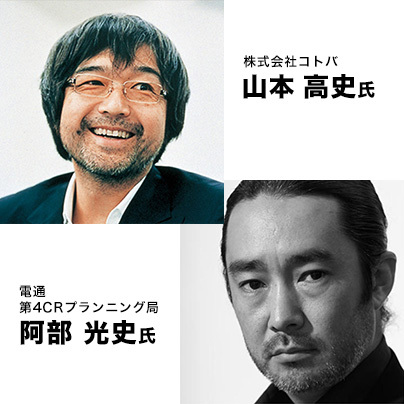Dentsu Design Talk vol.80
(Article Editing: Sugatsuke Office Composition Cooperation: Eiji Kobayashi Planning & Production: Dentsu Inc. Human Resources Bureau, Aki Kanahara)
Continuing from the previous session, under the theme "Living by Your Full Name," a discussion unfolded between Takashi Yamamoto (Kotoba Inc.), active as a Creative Director and Copywriter, and Mitsushi Abe, Creative Director at Dentsu Inc.'s Creative Planning Division 4.

The talk, where the creators themselves explained specific commercial works while viewing them, provided significant inspiration to the young creators gathered at the venue. Abe focused on the fourth point, "Story and Words," highlighting works with strong narrative elements. As a representative example, he cited Toyota's 'Corolla Fielder' campaign, which depicted soccer player Shinji Ono juggling a ball while shopping at a Dutch supermarket and interacting with a girl. When Abe remarked, "It was a successful campaign, but I don't quite grasp the connection between the depicted story and the mechanism driving mass product sales," Yamamoto responded, "That was largely the director's skill; I didn't do much myself." He elaborated, "The narrative offers a thrilling path to change – a young Japanese man establishing himself in the Netherlands and communicating with locals. This young representative is presented as the target user demographic." The campaign aired during the World Cup sponsorship period.
He also noted, "The greatest paradox of advertising is that for people who genuinely need and want to buy something, whether the commercial or ad is interesting is secondary." He then added, "Creating something interesting is fantastic. However, the primary effort must be accurately communicating the benefit. If that's done, the client shouldn't complain. The crucial sequence is to first ensure the essential message is conveyed, then make it interesting. We must constantly think of things that are interesting, appealing, cool, or beautiful; otherwise, there's no point in the creative process."
The fifth group is 〈Visuals and Words〉. The cited example, the 'Mitsubishi Materials' commercial, was one of Yamamoto's earliest works where he also handled directing. Here, he focused more on his directing experience than the words themselves, advising that copywriters, planners, art directors—anyone—should try directing themselves multiple times. "If you understand a director's perspective, you can build a good relationship with them when you hire one. If you can read estimates and schedules, you'll understand costs too. "When money is tight, using your wits is a creator's job. It trains you and helps you grasp what problems might arise. Especially for creative directors, whose job is to seamlessly oversee everything from upstream to the final output, it's crucial to think for yourself about what single thread connects everything when viewed from above. Don't define your own limits and assume someone else will do it for you."
The final group Abe categorized was "Music and Words." He noted, "Yamamoto rarely uses flashy music; instead, he often expresses emotion through piano while delivering the words," and asked about his approach to music. Yamamoto's stance is: "Due to budget and licensing constraints, I almost never get to use music I personally like. When commissioning someone, I want it to be background music that conveys my copy."
Yamamoto concluded by emphasizing the consistent creative communication principle underlying all his work: "Everything is decided by the audience." He noted this approach emerged after becoming independent, but recently he deeply appreciates the foundation built within the robust organizational environment of Dentsu Inc., where he previously worked. "Because the organization is solid and has many people and teams, you can fight freely. Advertising work involves mountains of tedious and tough tasks, but everyone at Dentsu Inc. seems to enjoy their work. I want you to start building the strength now to survive in that environment, to become someone who can stand on their own two feet using their full name, not just as 'Mr./Ms. [Name] from Dentsu Inc.' He sent this encouragement to the audience.






